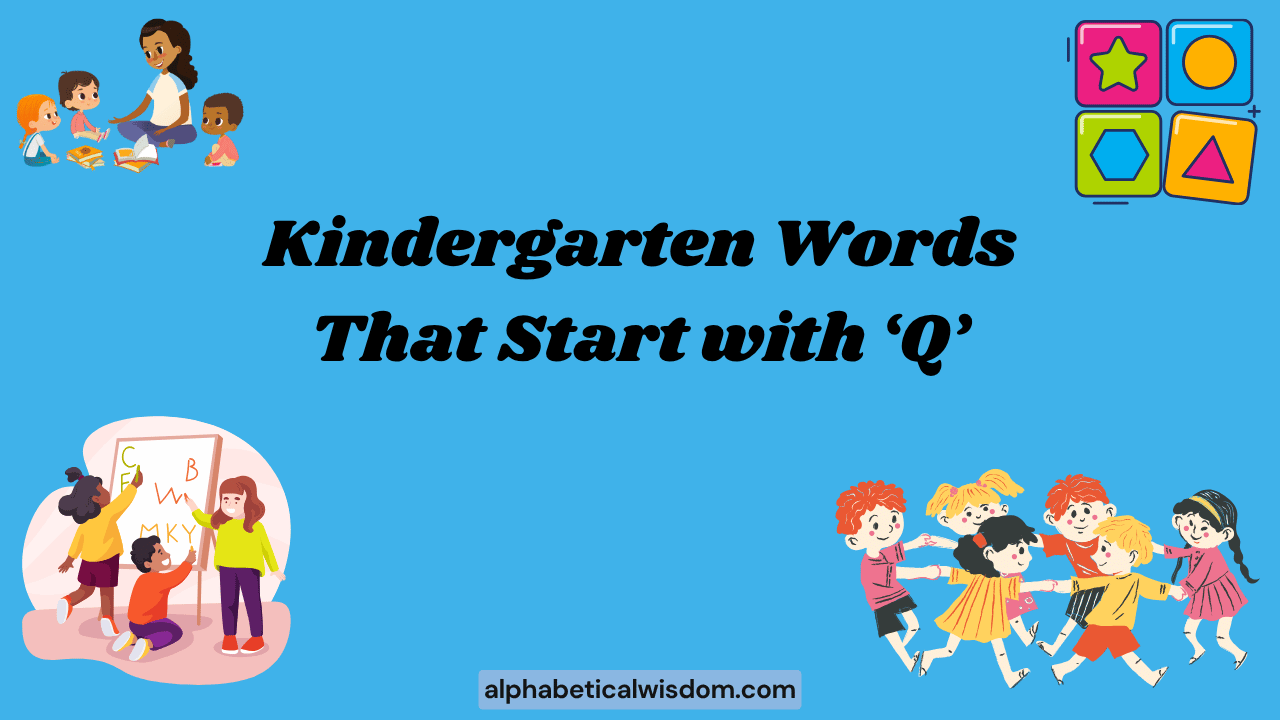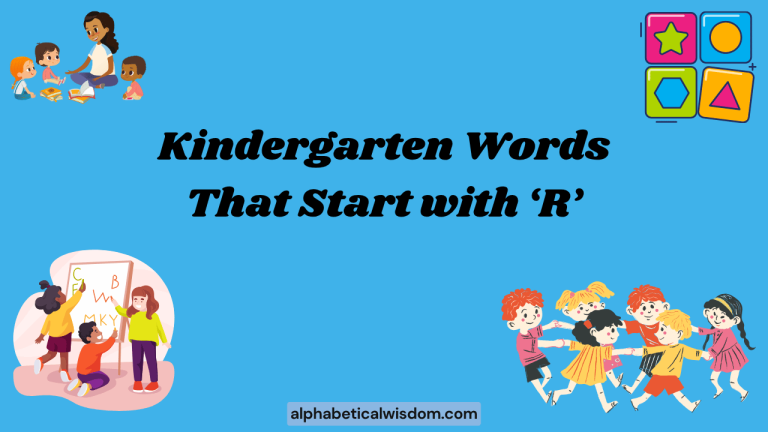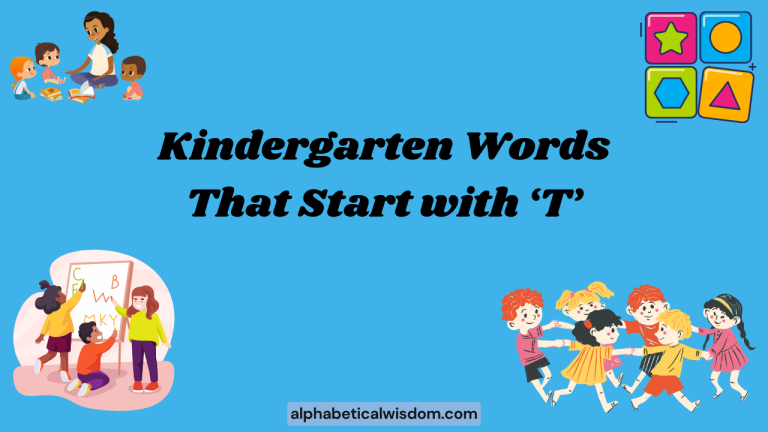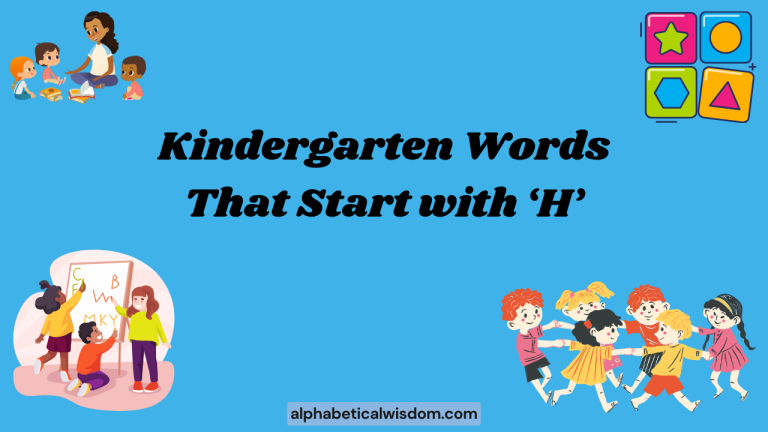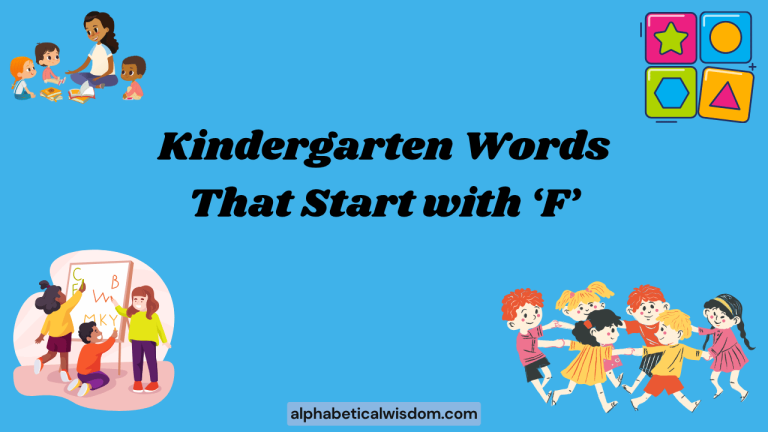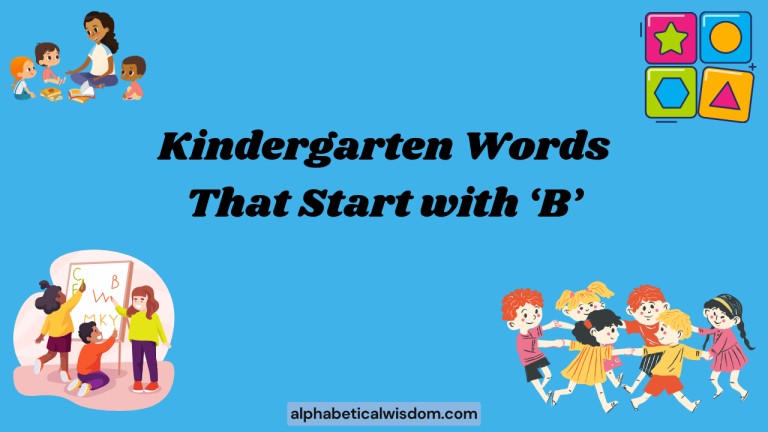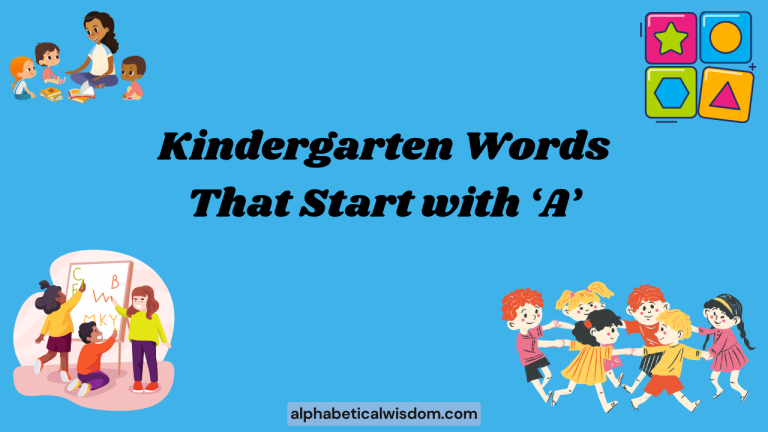Kindergarten Words That Start With Q: A Comprehensive Guide
Introducing young learners to the alphabet is a crucial step in their literacy journey. While some letters are frequently encountered, others, like ‘Q,’ can be less common and, therefore, more challenging.
Mastering words that begin with ‘Q’ is essential for expanding a child’s vocabulary, improving reading skills, and building confidence in language use. This guide provides a comprehensive exploration of ‘Q’ words suitable for kindergarteners, offering definitions, examples, and engaging activities to make learning fun and effective.
This resource is invaluable for parents, teachers, and anyone involved in early childhood education.
Table of Contents
- Introduction
- Definition of Kindergarten Words Starting with Q
- Structural Breakdown of ‘Q’ Words
- Types and Categories of ‘Q’ Words for Kindergarten
- Examples of Kindergarten Words Starting with Q
- Usage Rules for ‘Q’ Words
- Common Mistakes When Using ‘Q’ Words
- Practice Exercises
- Advanced Topics Related to ‘Q’ Words
- Frequently Asked Questions (FAQ)
- Conclusion
Definition of Kindergarten Words Starting with Q
Kindergarten words that start with ‘Q’ are terms suitable for young children aged approximately 4-6 years old. These words are typically simple, phonetically straightforward, and relevant to their everyday experiences.
The letter ‘Q’ is unique because it is almost always followed by ‘U’ in English, creating the ‘qu’ sound. Understanding this pairing is fundamental for young learners as they begin to decode words and develop their reading skills.
These words often represent concrete nouns or simple actions that are easily visualized, aiding comprehension and retention.
The primary function of introducing ‘Q’ words at the kindergarten level is to expand vocabulary and provide a foundation for future literacy. Exposure to a variety of words helps children develop phonemic awareness, which is the ability to hear and manipulate the individual sounds in words.
This skill is crucial for successful reading and spelling. Furthermore, learning ‘Q’ words encourages children to recognize and use the ‘qu’ digraph, a common sound pattern in English.
Creating a positive and engaging learning environment is key to fostering a love of language in young learners.
Structural Breakdown of ‘Q’ Words
The structure of ‘Q’ words commonly follows a consistent pattern due to the ‘Q’ being almost always paired with ‘U.’ This digraph creates a unique sound that is essential for children to recognize. Most ‘Q’ words are relatively short and simple, making them manageable for young learners.
Understanding the structure of these words helps children to decode them more effectively and improve their reading fluency.
The ‘Qu’ Digraph
The ‘qu’ digraph is the most important structural element in ‘Q’ words. It represents a single sound, typically /kw/. This sound is a combination of the /k/ and /w/ sounds, blended together. Children need to understand that ‘Q’ and ‘U’ work together to produce this unique sound. Recognizing the ‘qu’ digraph is crucial for both reading and spelling ‘Q’ words. Without this understanding, children may struggle to decode and encode these words accurately.
Common Word Endings
Many ‘Q’ words suitable for kindergarteners end with common vowel or consonant sounds that they are already familiar with. For example, words like “quiz” and “quit” end with consonant sounds, while words like “queen” often include common vowel digraphs or trigraphs.
Recognizing these common endings can help children to generalize their reading skills and apply them to new words. This builds confidence and encourages them to try reading unfamiliar words.
Syllable Structure
‘Q’ words for kindergarten are generally single-syllable words, making them easier to pronounce and remember. Single-syllable words are typically easier to decode because they contain only one vowel sound.
This simplicity is beneficial for young learners who are still developing their phonological awareness and decoding skills. As children progress, they can begin to explore longer, multi-syllabic words that contain the ‘qu’ digraph.
Types and Categories of ‘Q’ Words for Kindergarten
Categorizing ‘Q’ words helps young learners understand their meanings and usage more effectively. By grouping words into different types, such as nouns, verbs, and adjectives, children can begin to grasp the different roles that words play in sentences.
This categorization also aids in vocabulary development and comprehension.
Nouns
Nouns are words that name people, places, things, or ideas. ‘Q’ nouns suitable for kindergarteners are typically concrete and easily visualized.
These nouns often refer to familiar objects or concepts that children can relate to. Examples include “queen,” “quilt,” and “quarter.” Introducing nouns early on helps children to understand the basic building blocks of sentences and develop their descriptive language skills.
Verbs
Verbs are words that describe actions or states of being. ‘Q’ verbs are less common than ‘Q’ nouns, but they still play an important role in vocabulary development.
Examples include “quack” (the sound a duck makes) and “quit” (to stop doing something). Teaching verbs helps children to understand how actions are expressed in language and improves their ability to form complete sentences.
Adjectives
Adjectives are words that describe nouns. ‘Q’ adjectives are even less common than ‘Q’ verbs, but they can add nuance and detail to a child’s vocabulary.
An example might be “quiet” (describing a state of being). Introducing adjectives helps children to understand how to modify and describe nouns, making their language more expressive and descriptive.
Sound Words (Onomatopoeia)
Sound words, also known as onomatopoeia, are words that imitate sounds. The most common ‘Q’ sound word is “quack,” which represents the sound a duck makes.
Sound words are engaging and memorable for young learners, making them a fun addition to vocabulary lessons. They also help children to connect language with real-world sounds and experiences.
Examples of Kindergarten Words Starting with Q
Providing numerous examples of ‘Q’ words is essential for reinforcing learning and expanding vocabulary. These examples should be presented in a clear and engaging manner, with accompanying definitions and context.
Using tables and visual aids can help to make the examples more accessible and memorable for young learners.
Nouns Examples
The following table provides examples of ‘Q’ nouns suitable for kindergarteners. Each noun is accompanied by a definition and a sample sentence to illustrate its usage.
| Word | Definition | Example Sentence |
|---|---|---|
| Queen | A female ruler of a kingdom. | The queen wore a beautiful crown. |
| Quilt | A warm bed covering made of pieces of fabric. | I snuggle under my cozy quilt. |
| Quarter | One-fourth of something; a coin worth 25 cents. | I have a quarter in my pocket. |
| Question | A sentence worded or expressed so as to elicit information. | I have a question for you. |
| Quail | A small, ground-nesting game bird. | We saw a quail in the field. |
| Quay | A wharf or landing stage where ships can dock. | The boats were docked at the quay. |
| Quiz | A brief assessment of knowledge. | We had a fun quiz today. |
| Quiff | A lock of hair brushed upward and slightly backward from the forehead. | He styled his hair into a quiff. |
| Quip | A witty remark or comment. | She made a funny quip. |
| Quad | An open area surrounded on four sides by buildings | The students gathered in the quad. |
| Quokka | A small macropod native to Western Australia | The zookeeper showed us the quokka. |
| Quorum | The minimum number of members of an assembly or society that must be present at any of its meetings to make the proceedings of that meeting valid. | The meeting could not start because they didn’t have a quorum. |
| Quote | A group of words taken from a text or speech and repeated by someone other than the original author or speaker. | She used a quote from a famous author. |
| Quality | The standard of something as measured against other things of a similar kind; the degree of excellence of something. | The quality of the toy was excellent. |
| Query | A question, especially one addressed to an official or organization. | I have a query about the assignment. |
| Quest | A long or arduous search for something. | The knight went on a quest. |
| Queue | A line or sequence of people or vehicles awaiting their turn to be attended to or to proceed. | We stood in the queue for the ride. |
| Quantity | A particular amount of something. | The quantity of apples was large. |
| Quoin | An external angle or corner of a building. | The architect pointed out the quoin. |
| Quagmire | A soft boggy area of land that gives way underfoot. | The hikers got stuck in the quagmire. |
Verbs Examples
The following table provides examples of ‘Q’ verbs suitable for kindergarteners. Each verb is accompanied by a definition and a sample sentence to illustrate its usage.
| Word | Definition | Example Sentence |
|---|---|---|
| Quack | To make the sound of a duck. | The duck quacked loudly. |
| Quit | To stop doing something. | I will not quit trying. |
| Qualify | Be entitled to a particular benefit or privilege by fulfilling a necessary condition. | You need to study hard to qualify for the test. |
| Quench | Satisfy (one’s thirst) by drinking. | The water helped to quench my thirst. |
| Question | Ask (someone) questions. | The teacher will question the students. |
| Quarrel | Have a heated argument or disagreement. | The siblings often quarrel over toys. |
| Quiver | Tremble or shake with a slight rapid motion. | The dog quivered in the cold. |
| Quote | Repeat or copy out (words from a text or speech written or spoken by another person). | The teacher asked us to quote the poem. |
| Quantify | Express or measure the quantity of. | We need to quantify the results. |
| Query | Ask a question about something, especially in order to express one’s doubts about it or to check its validity or accuracy. | I need to query the invoice. |
Adjectives Examples
The following table provides examples of ‘Q’ adjectives suitable for kindergarteners. Each adjective is accompanied by a definition and a sample sentence to illustrate its usage.
| Word | Definition | Example Sentence |
|---|---|---|
| Quiet | Making little or no noise. | Please be quiet in the library. |
| Quick | Moving fast or doing something in a short time. | The rabbit was very quick. |
| Quaint | Attractively unusual or old-fashioned. | The village was very quaint. |
| Qualified | Officially recognized as being trained to perform a particular job. | The teacher is qualified to teach. |
| Quality | Of a high standard. | The food at the restaurant was quality. |
| Queasy | Slightly nauseated. | I felt queasy on the boat. |
| Questionable | Doubtful as regards truth or validity. | His story was questionable. |
| Quilted | Having a surface sewn in a decorative pattern. | The blanket was quilted. |
| Quintessential | Representing the most perfect or typical example of a quality or class. | The movie was the quintessential summer blockbuster. |
Sound Words (Onomatopoeia) Examples
The following table provides examples of ‘Q’ sound words suitable for kindergarteners. Each word is accompanied by a definition and a sample sentence to illustrate its usage.
| Word | Sound | Example Sentence |
|---|---|---|
| Quack | The sound a duck makes. | The duck said, “Quack!” |
Usage Rules for ‘Q’ Words
Understanding the usage rules for ‘Q’ words is crucial for accurate and effective communication. These rules govern how ‘Q’ words are used in sentences and how they interact with other words.
While the rules are generally consistent, there are some exceptions and special cases that learners should be aware of.
The ‘Qu’ Rule
The most fundamental rule for ‘Q’ words is that ‘Q’ is almost always followed by ‘U’ in English. This rule applies to the vast majority of ‘Q’ words, including those suitable for kindergarteners. There are a few rare exceptions, typically in words borrowed from other languages, but these are not typically encountered at the kindergarten level. The ‘qu’ digraph creates the /kw/ sound, which is essential for pronouncing ‘Q’ words correctly. This rule should be emphasized early on to prevent confusion.
Capitalization
‘Q’ words, like all words, must be capitalized when they appear at the beginning of a sentence or when they are proper nouns. Proper nouns are names of specific people, places, or things.
For example, “Queen Elizabeth” is a proper noun and should always be capitalized. Understanding capitalization rules is an important aspect of grammar and helps to ensure clarity in writing.
Pluralization
Most ‘Q’ nouns form their plural by adding an ‘s’ to the end of the word. For example, “queen” becomes “queens,” and “quilt” becomes “quilts.” However, there are some irregular nouns that do not follow this rule.
These irregular nouns are less common and typically not introduced at the kindergarten level. Teaching the basic pluralization rule is an important step in developing a child’s understanding of grammar.
Verb Tenses
‘Q’ verbs follow the same tense rules as other verbs in English. To form the past tense of regular ‘Q’ verbs, add ‘-ed’ to the end of the word.
For example, “question” becomes “questioned”. Irregular verbs do not follow this pattern.
It is important to introduce the concept of verb tenses gradually, starting with the simple present and past tenses.
Common Mistakes When Using ‘Q’ Words
Even with a solid understanding of the rules, learners often make common mistakes when using ‘Q’ words. Identifying and addressing these mistakes is an important part of the learning process.
By understanding the common pitfalls, learners can avoid making these errors and improve their accuracy.
Forgetting the ‘U’
The most common mistake is forgetting to include the ‘U’ after the ‘Q.’ Since ‘Q’ is almost always followed by ‘U’ in English, omitting the ‘U’ is a frequent error. This mistake can be avoided by emphasizing the ‘qu’ digraph and encouraging learners to double-check their spelling.
This is a crucial point to address early in the learning process.
Incorrect: Qeen
Correct: Queen
Mispronunciation
Another common mistake is mispronouncing the ‘qu’ sound. Some learners may struggle to blend the /k/ and /w/ sounds together correctly.
Practicing the pronunciation of ‘Q’ words and providing auditory feedback can help to correct this mistake. It’s important to model the correct pronunciation and encourage learners to imitate it.
Incorrect Pluralization
While most ‘Q’ nouns form their plural by adding ‘s,’ learners may sometimes make mistakes by adding incorrect endings or failing to pluralize the word when necessary. Reviewing the pluralization rules and providing ample practice can help to address this issue.
It’s helpful to provide examples of both regular and irregular plural nouns.
Practice Exercises
Practice exercises are essential for reinforcing learning and assessing comprehension. These exercises should be varied and engaging, providing learners with opportunities to apply their knowledge of ‘Q’ words in different contexts.
Including different types of exercises, such as fill-in-the-blanks, multiple-choice questions, and sentence construction, can help to cater to different learning styles.
Exercise 1: Fill-in-the-Blanks
Fill in the blanks with the correct ‘Q’ word from the word bank below.
Word Bank: queen, quilt, quiet, quick, question
| Question | Answer |
|---|---|
| 1. The ______ wore a beautiful dress. | queen |
| 2. I like to cuddle under my warm ______. | quilt |
| 3. Please be ______ in the library. | quiet |
| 4. The rabbit was very ______. | quick |
| 5. I have a ______ for you. | question |
| 6. The detective asked a difficult ______. | question |
| 7. She finished the test very ______. | quick |
| 8. The baby slept ______. | quietly |
| 9. The handmade ______ was very colorful. | quilt |
| 10. The ______ ruled the kingdom wisely. | queen |
Exercise 2: Multiple Choice
Choose the correct ‘Q’ word to complete each sentence.
| Question | Options | Answer |
|---|---|---|
| 1. Ducks ______. | (a) meow (b) quack (c) bark | (b) quack |
| 2. A female ruler can be called a ______. | (a) king (b) prince (c) queen | (c) queen |
| 3. What is another word for fast? | (a) slow (b) quick (c) lazy | (b) quick |
| 4. Please be _____ during the movie. | (a) loud (b) quiet (c) noisy | (b) quiet |
| 5. What is used to keep you warm in bed? | (a) sheet (b) Quilt (c) pillow | (b) Quilt |
| 6. I need to ask a ______. | (a) statement (b) question (c) command | (b) question |
| 7. The ______ fox jumped over the lazy dog. | (a) slow (b) quick (c) tired | (b) quick |
| 8. The librarian asked us to be ______. | (a) boisterous (b) quiet (c) rambunctious | (b) quiet |
| 9. My grandmother made a beautiful ______. | (a) blanket (b) quilt (c) comforter | (b) quilt |
| 10. The ______ sat on her throne. | (a) princess (b) queen (c) duchess | (b) queen |
Exercise 3: Sentence Construction
Create a sentence using each of the following ‘Q’ words.
| Word | Example Sentence |
|---|---|
| Queen | The queen greeted her subjects with a smile. |
| Quilt | My grandma sewed a colorful quilt for my bed. |
| Quiet | The classroom was very quiet during the test. |
| Quick | The quick brown fox jumped over the lazy dog. |
| Question | I have a question about the homework assignment. |
| Quack | The duck made a loud quack. |
| Quit | Never quit trying to achieve your dreams. |
Advanced Topics Related to ‘Q’ Words
While kindergarteners primarily focus on basic ‘Q’ words, there are more advanced topics that can be explored as learners progress. These topics delve deeper into the nuances of ‘Q’ words and their usage, providing a more comprehensive understanding of the English language.
Exceptions to the ‘Qu’ Rule
Although rare, there are some exceptions to the rule that ‘Q’ is always followed by ‘U’ in English. These exceptions typically occur in words borrowed from other languages.
However, these words are not typically introduced at the kindergarten level. Understanding these exceptions can help learners to appreciate the complexity and diversity of the English language.
Multi-Syllabic ‘Q’ Words
As learners progress, they can begin to explore longer, multi-syllabic words that contain the ‘qu’ digraph. These words can be more challenging to decode and pronounce, but they also offer opportunities for vocabulary expansion and improved reading fluency.
Examples of multi-syllabic ‘Q’ words include “quality,” “quantity,” and “questionable.”
Figurative Language with ‘Q’ Words
‘Q’ words can also be used in figurative language, such as metaphors and similes, to create vivid imagery and enhance communication. For example, someone might say, “He was as quick as a flash,” using the word “quick” to create a simile.
Exploring figurative language can help learners to develop their creative writing skills and appreciate the expressive power of language.
Frequently Asked Questions (FAQ)
This section addresses common questions that learners may have about ‘Q’ words. Providing clear and concise answers can help to clarify any misunderstandings and reinforce learning.
- Why is ‘Q’ almost always followed by ‘U’ in English?
The pairing of ‘Q’ and ‘U’ is a historical convention that dates back to Latin. The ‘U’ helps to modify the sound of the ‘Q,’ creating the /kw/ sound that is common in English words. This convention has been maintained over time and is now a standard rule of English orthography.
- Are there any words that start with ‘Q’ but don’t have a ‘U’ following it?
Yes, there are a few exceptions, but they are rare and typically found in words borrowed from other languages. Examples include “qi” (a Chinese concept) and “qat” (a type of plant). However, these words are not commonly used in kindergarten-level vocabulary.
- How can I help my child learn ‘Q’ words more effectively?
Make learning fun and engaging by using games, activities, and visual aids. Emphasize the ‘qu’ digraph and provide ample practice with pronunciation and spelling. Read books that feature ‘Q’ words and encourage your child to use these words in their own writing and speaking.
- What are some common mistakes to watch out for when using ‘Q’ words?
The most common mistake is forgetting to include the ‘U’ after the ‘Q.’ Other mistakes include mispronouncing the ‘qu’ sound and incorrect pluralization. Encourage your child to double-check their spelling and pronunciation to avoid these errors.
- How can I make learning ‘Q’ words more engaging for my child?
Use a variety of activities, such as flashcards, word games, and storytelling. Connect ‘Q’ words to real-world experiences and make learning interactive. For example, you could go on a “Q” scavenger hunt, looking for objects that start with the letter ‘Q.’ Also, utilize online resources, videos, and educational apps that can make learning fun.
- What is the best way to teach the ‘qu’ digraph?
Start by introducing the ‘qu’ digraph as a single sound unit. Use visual aids, such as letter cards and picture cards, to illustrate the connection between the letters and the sound. Provide ample practice with blending the /k/ and /w/ sounds together to form the /kw/ sound. Use repetition and positive reinforcement to help learners master the digraph.
- How do I explain what a “queen” is to a kindergartener?
Explain that a queen is like a very important leader, just like a king, but she is a woman. She lives in a castle or palace and helps take care of her country and its people. You can show pictures of queens from storybooks or real life to help them understand.
- What are some fun activities to practice ‘Q’ words?
There are many fun activities! You can play a “Q” word matching game where the child matches pictures with the correct word. Another is to have them draw pictures of objects that start with “Q” and label them. You can also create a “Q” word search puzzle or play “I Spy” using objects that begin with the letter “Q”.
- Are there any songs that can help teach ‘Q’ words?
While specific songs dedicated solely to “Q” words might be rare, you can adapt alphabet songs to emphasize the “Q” sound and related words. You can also create your own simple rhymes or songs using “Q” words in a fun and repetitive manner. For example, “Q is for queen, so grand and serene!”
- How can I differentiate instruction for students who are struggling with ‘Q’ words?
For students who struggle, provide extra support by breaking down the ‘qu’ sound into smaller steps. Use tactile materials like playdough or sand to form the letters “Q” and “U”. Offer one-on-one tutoring or small group instruction to provide personalized attention. You can also use simpler, more familiar “Q” words to start with, gradually increasing the complexity.
Conclusion
Mastering kindergarten words that start with ‘Q’ is a significant step in a child’s literacy development. While the letter ‘Q’ may seem challenging due to its unique pairing with ‘U,’ a systematic and engaging approach can make learning fun and effective.
By understanding the structure of ‘Q’ words, exploring different categories, and practicing regularly, young learners can build a solid foundation for future literacy success. Remember to emphasize the ‘qu’ digraph, provide ample examples, and address common mistakes to ensure a positive and rewarding learning experience.
Encourage children to embrace the challenge of learning ‘Q’ words and celebrate their progress along the way. With patience, encouragement, and the right resources, they can confidently expand their vocabulary and develop a lifelong love of language.
Continue to reinforce their knowledge through reading, writing, and interactive activities. By fostering a supportive and stimulating learning environment, you can help children unlock their full potential and achieve their literacy goals.
